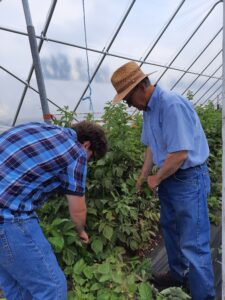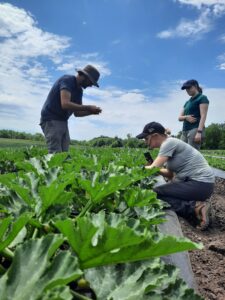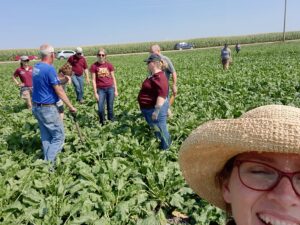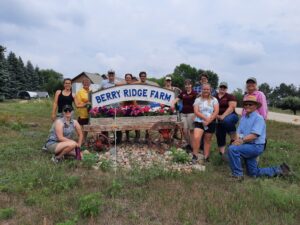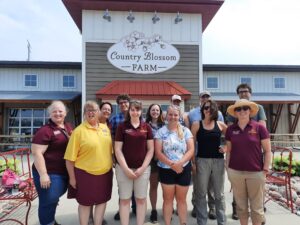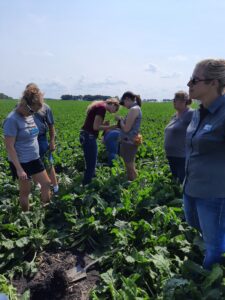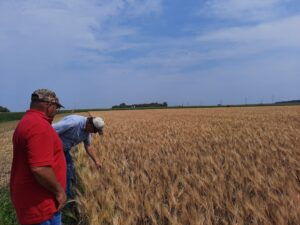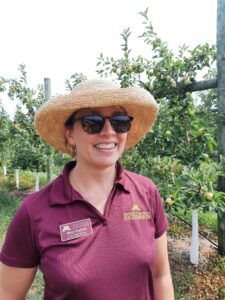Final report for ENC20-197
Project Information
Modeled loosely after the SARE Fellows program, this project created a network of University of Minnesota Extension educators with a common understanding and framework to help Minnesota farmers address sustainability issues. Using a cohort model, the goals of the project were to increase their understanding of sustainability issues in agriculture, increase their skills and tools to help farmers make decisions, and increase their network of peers to support farmers further. Activities included one online overview meeting, 3 learning sessions (each with an online meeting and on-farm learning laboratory) related to common agricultural operations in Minnesota(horticulture, row crops, and livestock), and a reflection and planning meeting. Participation was lower than expected, due to the COVID19 pandemic, so remaining funds were used by soliciting project ideas from cohort members. This resulted in three member-led projects; beneficial insect identification training, cover crop utilization field day, and small and beginning livestock farmer resource toolkit. Twenty seven educators participated in the cohort and could choose which of the three sessions to attend. Each session had roughly twelve participants. Cohort membership survey responses indicate they did build knowledge regarding sustainable agriculture issues, have used knowledge from this project in their work, and have grown their peer networks.
- Increase 25 University of Minnesota Extension educators’ fundamental knowledge of sustainable agriculture concepts related to Minnesota’s most common types of agriculture horticultural crops, row crops, and livestock.
- Increase the skills and tools of 25 University of Minnesota Extension educators to help farmers make decisions about sustainability issues.
- Increase the working networks of 25 Extension educators across Minnesota to increase their capacity in supporting farmers with sustainability issues.
Cooperators
Education
Extension educators, like farmers and many people, learn well together and in hands-on experiences. This project used a cohort learning model, where a small group of people go through an experience together. This allowed them to learn in a setting where they feel supported to ask questions without feeling embarrassed. They learned from each other's knowledge and the questions others asked. Cohort models also build a network of peers to help each other learn beyond the formal time of the cohort. So this cohort will help disseminate information further beyond those in the cohort as well. This project combined the cohort model with hands-on learning model, going to visit with farmers on their own farms. Thus they experienced the farms and asked questions based on what they observe, which helped solidify the learning.
Education & Outreach Initiatives
Increase 25 University of Minnesota Extension educators’ fundamental knowledge of sustainable agriculture concepts related to Minnesota’s most common types of agriculture horticultural crops, row crops, and livestock.
The first online meeting covered the overall concepts of the three legs of sustainability in agriculture. Then for each of the 3 areas of agriculture; horticultural crops, row crops, and livestock, there was a learning session that included an online meeting and an on-farm learning lab. For each of the on-farm labs, two types of operations were visited to understand the variety and different circumstances of different types of operations. Also, the learning sessions were held in 3 distinct regions of Minnesota to show the variation of conditions in Minnesota. They were in Alexandria, MN (central lakes), Buffalo Lake, MN (prairie), and Ogilvie (edge of north woods). Participants received detailed backgrounds on the farms in the online meeting, and discussed their sustainability issues with the farmers. Thoughts on strengths and challenges were gathered for each farm after the visits.
Due to COVID-19, the project was delayed getting started and fewer educators were able to participate than expected. The reduced participation left funds remaining in the budget. To make use of the funds, and to build the group’s skills, they were asked to develop projects that fit with the project’s goals and present them to the group. Three projects were designed and executed by cohort members, sharing their knowledge with the group. They covered beneficial insect identification in horticultural crops, cover crop utilization, and beginning and small scale livestock producer resources.
A survey was given to participants after each learning session. Every session showed learning gains in sustainable agriculture issues, with the largest gains related to:
- Horticulture farm business models
- Horticulture farms labor needs
- Row crop selection options
- Row crop equipment needs
- Livestock operations balancing the 3 legs of sustainability
- Livestock labor management and roles
In an end of project survey of twenty cohort members, all of the 15 respondents agreed that they learned about sustainable agriculture principles and practices, 73% of those indicated learning some or a lot.
With the funds remaining, three cohort member-led projects were chosen to extend the work. Each had a component of sharing their content expertise with the group, helping deepen the group’s knowledge. The projects’ impacts on common understanding of sustainable agriculture issues were related to:
- Beneficial insect identification on fruit and vegetable farms. Entomologist cohort members trained other members to identify pests across the state throughout the growing season, with existing materials. This strengthened the entomology knowledge of the 12 participants in that project.
- Cover crop utilization and resources. A cover crop field day was planned and executed for educators and farmers in Southwest Minnesota, increasing knowledge across the state regarding row crop production. A survey conducted at the event highlighted cover crop research and education topics desired by the farmer participants. There were an estimated 20 farmers, 27 agency and non-profit organization staff, and 2 university staff at the meeting.
- Small and beginning livestock farmer resources. A web-based toolkit for educators, https://sites.google.com/umn.edu/strengthenrelationshipstoolkit, to help small and beginning livestock farmers was created by two members and is being shared with the other 25 county-based educators in the state. This was based on focus groups conducted with eight small and beginning livestock farmers. It will help increase the knowledge of educators across Minnesota regarding available sustainability resources for livestock producers.
Increase 25 participants’ skills and tools to help farmers make decisions about sustainability issues.
Building skills and tools to help farmers make decisions was woven throughout the project. Some cohort members needed to build skills in one on one discussion with farmers. Others needed to build skills in creating educational tools, curriculum to share and designing programs.
Developing the one on one skills happened in conversations with NRC SARE coordinators and colleagues from other states regarding various issues, using the ‘Reading the farm’ curriculum pieces, and reflecting on what they saw and learned on farms. Cohort members were able to practice asking questions to dig into issues related to sustainability issues, and how they are addressing the issues. For the learning sessions, participants were given lists of common issues found within the 3 legs of sustainability for future reference. For each of the three farm areas (horticulture crops, row crops, and livestock) the online meeting included a knowledgeable guest NCR SARE state coordinator. A conversation was facilitated with them regarding the issues in Minnesota and the North Central Region, and how farmers are addressing them or the barriers present. This enabled the participants to then attend the on-farm labs and practice helping farmers through asking informed questions.
Building skills in creating relevant education materials and tools started on farms by seeing a variety of situations and noting similarities in pain points or educational needs. It continued in the reflection and planning meeting. Here the group spent time reflecting on what they learned about sustainability challenges and commonalities amongst farmers, synthesizing what they learned. They participated in an exercise to list Extension educational programming related to sustainability in agriculture; current, upcoming or pending, and needed programs. This helped practice articulating what they are seeing as needs and possibilities, so they have clear goals in their work moving forward. It was practiced in those who brought forth proposals, in crafting their ideas and shaping it based on peer feedback.
Participants were able to identify strengths, challenges, opportunities and threats for every farm, giving them the opportunity to think critically about a farm's situation. This also allowed them to practice counseling farmers through decisions based on informed questions.
In the reflection and planning session, the participants identified Extension programming related to sustainable agriculture that is currently existing, coming soon, or is needed. Thus they are more able to create relevant tools and programming.
Each project proposed by cohort members contained a component of teaching each other more, and providing resources for the group and beyond. This indicates that the group is willing to offer their skills and knowledge to the group and beyond. The beneficial insects project built skills in insect identification for twelve Extension staff, and in the project lead’s abilities in designing the educational opportunity. The survey results from the cover crop field day can be used by others in designing future tools for farmers related to cover crops. And developing the small and beginning livestock toolkit increased the leads’ skills in educational tool development. Also, the tool itself is currently being shared with county educators across Minnesota, who will use it and help improve it.
In the post project survey, 100% of respondents indicated they have used knowledge and skills learned through this project (or incorporated project materials) in educational activities, services information and/or tools for farmers.
Increase the working networks of 25 Extension educators across Minnesota to increase their capacity in supporting farmers with sustainability issues.
Each meeting opportunity had both informal and formal time allotted for networking and relationship building. Informal opportunities included visiting before, during and after meetings, and unstructured lunches during meetings and on-farm learning lab days. The formal opportunities included activities such as introductions at the beginning of each session, two truths and a lie, and small group reflections. Also, working on a project of shared interest strengthened new connections.
The exact number of relationships grown is difficult to quantify. Some relationships were among cohort members, and others were beyond the group. However, survey results indicate this project grew members’ networks of colleagues.
In the post-learning lab surveys, the highest learning gains in any category were in the area of Extension peer networks. In the Horticulture and Livestock sessions, 100% of survey respondents gained 'much' or 'very much' knowledge of peers to collaborate with.
In the post project survey, the mean number of working relationships grown per member was 8 educators, 4 farmers and 3 professionals from other organizations. One person indicated they have grown 20 relationships with Extension peers based on this project. A conservative estimate is that each of the 27 cohort members built at least one relationship during the project, most likely, more.
With the high number of new educators and COVID-19, networking with peers has been especially challenging. Some of the cohort members started their positions during the pandemic and these meetings were their first opportunity to meet other Extension colleagues in person. This project was an important part of welcoming them into the organization.
Educational & Outreach Activities
Participation Summary:
Learning Outcomes
Project Outcomes
This project accomplished its overall goals while evolving. The original plan of an overview session, three workshops (each with an online preparation meeting, and on farm meeting), and reflection and planning meeting occurred. We had 27 people in the cohort with roughly 12 members at each workshop.
Due to COVID-19, the project was delayed getting started and fewer educators were able to participate than expected. The reduced participation left funds remaining in the budget. To make use of the funds, and to build the group’s skills, they were asked to develop projects that fit with the project’s goals and present them to the group. Three projects were designed and executed by cohort members:
- Beneficial insect identification group. Entomologist cohort members trained other members to identify pests across the state throughout the growing season, with materials created for their use. There is now a tight knit group of educators helping each other with insect identification for fruit and vegetable farmers in Minnesota.
- Cover crop resources. A cover crop field day was planned and executed for educators and farmers in Southwest Minnesota, with a survey of farmers related to their topic needs for research and education, increasing capacity across the state and region.
- Small and beginning livestock resource toolkit for educators. A web-based toolkit for educators to help small and beginning livestock farmers was created by two members and is being shared with county based educators. This was based on focus groups conducted with small and beginning livestock farmers. It will help educators across Minnesota better connect farmers to available resources regarding sustainability.
The survey at the end of the project showed evidence that we accomplished the goals of the project. First, they increased common understanding of sustainable agriculture issues. All respondents agreed that they learned about sustainable agriculture principles and practices, 73% of those indicated learning some or a lot. Second, they increased their working networks with fellow educators, farmers, and other agency personnel. The mean number of working relationships grown per member was 8 educators, 4 farmers and 3 professionals from other organizations. Third, all indicated they have used knowledge and skills learned through this project (or incorporated project materials) in educational activities, services information and/or tools for farmers. The group was able to articulate where they felt University of Minnesota Extension’s strengths and opportunities lie regarding sustainable agriculture educational programming.
This project accomplished its goals. It created a network of Extension educators in Minnesota with a common understanding and framework to help Minnesota Farmers address sustainability issues. They have started and will continue to move the dial in increasing sustainability in agriculture in Minnesota.
In addition to the planned outcomes, there were bonus outcomes towards the end of the project. Participation in the three added projects was also lower than expected, so there were still funds available. Three projects led by others in Extension had goals that aligned well with this project and had cohort members participate in them, so we were able to support those as well.
First, there was a gathering of county-based educators, several of whom were cohort members. We were able to help support their networking as well as learning about programming collaborations around sustainability and SARE resources. During the project, there was turnover in staff, and this was an opportunity to fold eight newly hired and non-cohort educators into the project. While they did not get the entire cohort experience of the project, especially regarding the sustainable agriculture principles and practices, cohort members built networks with the new educators with the goal of including them in future programming efforts and sharing resources.
Second, a cohort member developed an opportunity to teach twelve other educators about apple pruning techniques for disease management and profitability. Participants were also given a presentation they could use with apple growers in their areas.
Third, we were also able to support a gathering of educators and researchers, including some cohort members, in building networks for programming efforts regarding food systems work. This again connected eleven more educators and five researchers to others in the University working in food systems. They drafted a gap analysis, assets list, and goals for their work, which will lead to successful future programming around sustainable agriculture issues.
